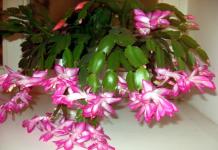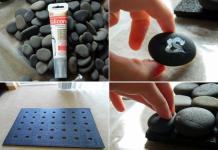Home care for the Decembrist should correspond to natural conditions as much as possible. This plant is native to their tropical forests, where it is always warm and humid. Therefore, the key to the good development of this indoor flower is to maintain the same air temperature in the room.
It is necessary to consider in more detail how to care for the Decembrist at home and what recommendations should be followed so that this plant pleases with its decorative appearance for as long as possible.
- 1 part of sod land;
- 2 parts of leaf land;
- 1 part sand.
- 3 parts of leaf land;
- 1 part of sod land;
- 1 part sand;
- 2 parts humus.
- sheet and sod soil;
- sand;
- peat.
- close inspection of a cactus. It should not have yellowed or swaying areas. Perennial should be fresh, juicy and resilient.
- matching the capacity to the size and age of the plant. A pot that is too large or too small requires immediate repotting. But due to the fact that after a change of residence it is prohibited for a long time, the barbaric beauty can have time to acquire many diseases.
- lack of signs of diseases and attacking insects. Almost all unexpected guests are visible to the naked eye and it will not be a problem to notice them.
- soil density and moisture. Ground that is too dense and wet is a sign of a containment breach. Such an exotic is potentially sick.
- well-formed crown. To avoid difficulties with pruning, it is better to choose a decoratively attractive specimen.
- white. An elegant snow-white flower pleases with abundant and long flowering. Multiple buds completely cover the leaves and stems.
- Buckley. The most durable kind. Able to withstand many changes and even a sudden change of scenery. Reaches up to 50 cm in height. It has large buds and dark green leaves. It blooms the longest of all species - from November to March. It has an amazing variety of colors.
- truncated. The leaves are pointed, dark green in color. Flowers are two-tiered, with bent petals. The color palette is diverse: pink, white, lilac, yellow.
- mealybug;
- spider mite;
- scab.
- Daily spraying of the plant with settled water.
- Place the flower pot on a tray with wet drainage, peat moss or moss.
- peat - 2 parts;
- fertile soil - 1 part;
- coarse sand - 1 part.
- Insufficient watering.
- Insufficient lighting.
- The plant is cramped in a pot and needs a transplant.
- Insufficiently nutritious soil.
- In winter, the plant is recommended to be illuminated with an additional light source.
- During the flowering period, you can not move and turn the pot, as well as prepare cuttings for propagation.
- It is strictly forbidden to expose the plant to temperature changes during flowering.
- If there is cool air in the room, then flowering will last longer.
- The bush will bloom profusely in a narrow pot.
- More active flowering is promoted by a temperature regime not higher than + 16C.
- After a dormant period, watering and fertilizing are resumed very carefully. Otherwise, the plant can get a lot of stress and drop buds.
- If the plant is infected with pests, then it is treated with special preparations.
- If the leaves of the plant are clean and there are no insects on them, then perhaps the reason is a lack of nutrients. In this case, the Decembrist is watered or sprayed with fertilizers for epiphytic cacti.
- The reasons for the fall of the end segments can be: a draft, sudden changes in temperature, too dry air, or an untimely transplant.
Show all
If a person decides to buy a Decembrist flower for himself, how to care for him and what absolutely cannot be done with the plant, the seller is obliged to tell. Decembrist flowers (Latin Schlumbergera) are also called zygocactus, Schlumbergers or Christmas trees. This is a cactus that does not have thorns, loves water and is afraid of the sun. The birthplace of these unique ones is South America, where they can be found not on window sills, but on tree branches. Decembrists, or Christmas, these succulents were nicknamed because of their late flowering. This period lasts from November to January, when all other houseplants are at rest. But there is nothing strange in this, because the peak of tropical summer coincides with our winter months.
This flower does not like southern window sills, so the hostess will not need to puzzle over where to put the Christmas tree. It can be grown both as a regular and as an ampel houseplant.
During the budding period, the plant should not be disturbed, because even a slight turn of the pot can affect the quality of flowering. If you follow all the rules for caring for a Decembrist flower, then this centenarian will delight you for about 15-20 years not only with its colorful shoots, but also with decorative flowers.
Temperature regime
Indoor Decembrist flower at home grows well, if you do not expose it to temperature changes. It is recommended to constantly maintain the temperature in the room where the plant is located, in the range of +18...+25°C. But this does not mean that any temperature fluctuations will provoke the death of this cactus. He is able to endure both 2 ° C and 37 ° C, but it is not worth testing the plant for strength.

It is recommended to regulate the temperature depending on the period of development of the Decembrist. In autumn, the Christmas tree is preparing to bloom, and he needs to gain strength. To make this period as comfortable as possible, it is desirable to maintain the temperature in the range of +12...+16°C.
Since the flowering of the Decembrist falls in the winter, you need to make sure that the temperature in the house is not lower than + 18 ... + 20 ° С. For the optimal flow of the active phase, the flower needs a sufficiently high temperature. After budding, the Decembrist cactus can be transferred again to a cooler place.
As for the location of the flower, it is recommended to give preference to the eastern windows. You should not put a pot with a plant on the southern windowsills or next to them, since from direct sunlight on the cactus, the segments of its stems may first turn yellow, then crumble. In the event that it is not possible to provide the cactus with diffused light, it is advisable to make a shadow for the flower yourself.
Humidity and watering
It is necessary to water the Decembrist according to the principle of moistening deciduous plants. The main thing to always remember is that this should be done in moderation and in accordance with the periods of development.
The active phase of flowering requires abundant watering. The hostess needs to constantly ensure that the soil in the pot does not dry out. In winter, it is desirable that the soil is constantly wet. When the Christmas tree has faded, it needs to be watered less frequently. Until April, plant moisture should be gradually reduced.
In summer, when the flower is at rest, it needs moisture only if the soil dries out. But it is also not necessary to wait until the entire soil is completely dry, it is enough that only its upper layers lose moisture.

In autumn, the Decembrist bush also needs to be watered extremely rarely. Until the moment when buds begin to form on its stems, it is advisable to keep the pot in a cool room and rarely moisten.
So that in the hot season the flower does not dry out, it can be sprayed. In houses where the air is too dry, this cactus will not take root. He loves high humidity, so it is recommended to spray as often as possible. Alternatively, a flower pot can be placed on a pallet of wet pebbles. But in this case, you need to make sure that the roots of the plant are not in the water, otherwise they may begin to rot.

Feeding the Christmas tree
Caring for the Decembrist at home also provides for the periodic introduction of special fertilizers for the plant into the soil. It is better to give preference to complex compositions. They can be introduced into the soil from March, when the Decembrist has faded. The frequency of feeding during this period is 1 time per month. This is enough to make the plant feel comfortable.
Usually, zygocactus are fed with floral mineral fertilizers, but use half the rate indicated on the package. Care must be taken to ensure that the dose does not contain too much nitrogen. This component can cause root rot.

In summer, top dressing can be increased. For intensive growth of stems, it is desirable to fertilize the soil once every 2 weeks. Starting from September, when the Christmas tree is preparing for flowering, soil enrichment must be stopped. Many housewives complain: I fertilize the Decembrist all year round, but it still does not bloom. It is imperative to take into account the phases of development of this flower and, in accordance with them, carry out top dressing. Otherwise, the original flowering can not be seen.
Zygocactus transplant
A Decembrist transplant usually falls at the end of February, when the plant has completely faded. Young Christmas trees are recommended to be transplanted at intervals of 1 time per year, adult specimens need to be transplanted much less often - 1 time in 3 years. If a very large bush grows in the house, then you should not disturb it too often. He can change the capacity and soil about 1 time in 5 years.
When choosing a new container, you need to pay attention to the fact that the roots of the Decembrist are superficial. Wide and shallow pots suit him best. A third of the container should be filled with drainage.
When transplanting, you can use special soil for cacti. If you have time, it is recommended to prepare the soil yourself.

There are 2 options for creating an earthen mixture for zygocactus. The first includes the following components:
For the second version of the earth mixture, you need to prepare:
Whatever option for preparing the earth mixture is chosen, it should always be slightly acidic. So that the soil has better water permeability, it can be mixed with brick chips.
The Decembrist should be transplanted carefully so as not to damage the root system. If you failed to do this carefully, disinfect the damaged roots with crushed charcoal.

Breeding technique
The Decembrist flower, the care and reproduction of which cannot be considered too troublesome, can often be found on window sills. Mistresses often breed these plants on their own so that they please the eye in every room.
How to propagate the Decembrist, if the house already has one pot with this plant? Usually this is done vegetatively, that is, by cuttings. From the escape, you must carefully tear off the two extreme segments. Reproduction does no harm to the Decembrist, so you can safely unscrew the cuttings. You can not immediately transplant them into the soil, you need to leave them to dry for several days. While the segments will get rid of excess moisture, the hostess should start preparing special containers or seedling boxes.

Plant containers should be filled with moist soil. Then it is required to place the dried segments of the Decembrist there. It is recommended to cover the container with a film or glass to create a greenhouse effect. This will help the shoots to take root and quickly take root. Such boxes must be placed in the shade and ensure that the air temperature is in the range of + 15 ... + 20 ° С.
Every day, the film or glass must be removed for a while so that the seedlings are ventilated. Periodically, the soil needs to be moistened, then rooting will occur much faster. If you want to feed the shoots in transplant containers, then it is recommended to abandon this idea. High humidity and warm temperatures are enough for the segments to take root.
No need to puzzle over how to transplant shoots into a regular pot. You just have to wait until they get stronger. Then you can transplant according to the same principle as for adult plants.
Experienced flower growers recommend propagating the Decembrist during pruning. After such a procedure, a lot of planting material usually remains. If there is no desire to throw it away, you can dry the cuttings and place them in a container for a while.

How to ensure abundant flowering?
The flowering of the Decembrist can be considered not only the dignity of this succulent, but also the result of careful care for it. The main role in this process is assigned to the temperature regime. If in the fall, when the flower begins the budding period, it will stand at a temperature above 23 ° C, then the plant will begin to grow shoots, but certainly not the inflorescences. Flower buds are perfectly formed at a temperature of +17...+20°C, there is a possibility of their laying at a temperature of +10...+15°C. If during this period the flower was in a room where the temperature is below 10 ° C, do not expect flowers in winter.

The Christmas tree will bloom longer if it is placed in a cool room during the active phase. If it was transferred, for example, to a glazed terrace, then you do not need to touch the pot until the plant has completely faded. Even slight temperature changes can interrupt flowering, because this plant is able to drop even those buds that are almost open.
When the zygocactus blooms, it cannot be cut. Also during this period, you should not prepare cuttings for propagation. It is desirable to provide the plant with additional lighting, then it will delight with its flowers much longer.
If a blooming Decembrist is purchased, you need to prepare for the fact that the flowers may fall off. Due to a change of place, the plant is able to lose, if not all, then part of its buds, since the process of adaptation in a Christmas tree is usually difficult.

Frequent illnesses
Zygocactus can often be exposed to various diseases, so it is recommended to periodically inspect the leaves of this flower in order to detect the pest in time.
Often a Decembrist flower at home is affected by a mealybug. It appears as whitish lumps between the shoots. The plant must be urgently treated with special preparations (for example, Actelkik), otherwise it may die.
A rusty coating and a barely noticeable cobweb indicates the presence of a spider mite. These insects appear at low humidity. The plant must be treated with Fitoverm or Neoron.
Phytophthora, phytum and fusarium are fungal diseases that affect the root neck of a plant. Infection provokes the wilting of the flower in moist soil, the leaves become gray and pale. It is best to get rid of the fungus with the help of Topaz and Vitaros. To prevent the occurrence of these diseases again, it is recommended to water the soil less often and make sure that it has time to dry well.
Caring for a Decembrist flower at home is easy if you put it in the right place from the very beginning and provide it with the same temperature regime. If you follow the recommendations, then the Christmas tree will bloom every year.
If you want to dilute the frosty days with bright flowering, then you should buy this luxurious flower, which fully justifies its name. It is also called barbarian scythe, cancer neck, Christmas tree, and the botanical name is Schlumberger. The unusual shape of the shoots and unpretentiousness have made it a very popular potted plant all over the world. This long-liver is able to please the owner with its decorative appearance for more than 18 years. He comes from the Brazilian tropics, belongs to the cactus family.
The Decembrist prefers shade or partial shade, watering should be frequent but moderate, you can spray the plant.
Able to grow almost everywhere: strengthening due to the root system on a tree trunk, in a crevice of the bark, etc. The epiphyte has no spines. The flowers are tubular multi-tiered, located at the very tips of the shoots. The typical color is bright: rich red or snow-white. The varieties bred by breeders boast a wide variety: raspberry, lilac, lemon, pale pink. A long bunch has fragile stamens. The flowering period is long: from December to mid-February.
Growing and caring for a flower
Locations and required lighting
Grows well on a light, but shaded, windowsill. It is preferable to select a north or east window. Direct sunlight is strictly prohibited, they can cause severe burns in perennials. During solar activity, an artificial shadow is created.
Temperature
The optimal mode in the cold season is 16 degrees. In summer, flower growers take the pot out into the fresh air (balcony, terrace). The place should be shady and cool. During the dormant period, the container is periodically rotated around its axis to form a crown of the correct shape. During the flowering period, this should not be done.
Choose a ready-made soil or prepare it yourself
You can buy in a specialized store (substrate for succulents or cacti) or cook it yourself. To do this, take in equal parts the following components:
Add a small amount of crushed brick and expanded clay. To destroy all possible bacteria, crushed activated charcoal is added. Pay special attention to the drainage layer. They fill at least 40% of the total volume of the pot.
Choosing the best pot

Do not neglect the size and shape of the pot, otherwise the flower may be seriously damaged.
Wide but low preferred. This is due to the superficial development of the root system. Drainage holes are required.
Watering and moisturizing
It is carried out with settled water at room temperature. It is advisable not to use tap water, preferring purified moisture. Varvara Spit gratefully responds to frequent and moderate watering; in the warm season, summer rain is arranged. But at the same time, care must be taken not to touch the buds and inflorescences. Droplets cause rot.
Too wet soil is a source of fungal diseases. It is acceptable to use a pallet with expanded clay. It helps the Decembrist to avoid moisture deficiency, while it does not come into contact with the plant itself. Excess moisture that drains after watering is poured out.
Plant nutrition
Performed every 4 weeks. Fertilizers are applied in liquid form. He is suitable for universal complexes for cacti and succulents. They are applied strictly according to the scheme indicated on the package. Their overabundance negatively affects the growth and development of the Decembrist. It is acceptable to apply a weak solution of fertilizer for potted crops. The flowering period is a signal to suspend any plant support with beneficial substances.
pruning
It is carried out to create the correct shape of the crown in early summer. But there is a twisting method. Incorrectly growing shoots are not pruned.
Transplantation and rest
After the end of flowering, the cancerous neck needs rest until spring. The owner should move it to a cool, shady place. Watering at this point is significantly reduced. In April, the Christmas tree is returned to its usual conditions: they are transferred to their original place, and the usual moistening schedule is resumed. In the spring, fertilizing begins.
After flowering (at the end of winter), you can transfer the bush to another flowerpot. For a young individual, this is an annual necessity. An adult representative needs to be transplanted every 5 years. The soil should be slightly loosened. Do this carefully and shallowly, along the edges of the container. The Decembrist is removed along with an earthen clod. Then it is carefully washed off under a stream of warm water. Drainage is necessarily present in the new container, the first part of the substrate is poured on top of it. A bush is slightly pressed into it, the pot is filled with the rest of the soil and gently crushed. The process ends with abundant watering.
Pests and diseases
rocking barrel
The first sign of hypothermia due to low air temperature or ice water humidification. But it can also signal an overabundance of fertilizers or overheating from direct sunlight. Transplanting into fresh soil and normalizing the conditions of detention can counter the problem.
root system rot

Rotting of the roots of the Decembrist is mainly due to waterlogging.
After strong moisture, the plant may die. Complete replacement of the soil and strict adherence to irrigation rules will help save it.

Its appearance can be guessed from the shedding of segmented stem segments. It is necessary to spray with special chemicals - insecticides. In a rare case, insect infestation is confused with a lack of nutrients.
If during the inspection no pests are found, then the Decembrist can be helped by applying top dressing in liquid form.
Stress
Multiple factors can cause it: improper care, transplantation, long-term transportation, a sharp change in environmental conditions. Negative changes can bring the Schlumberger to death. Only the creation of favorable conditions for it will help to grow a full-fledged and healthy plant.
fungal diseases
Transmitted from an infected plant. Most often this happens in a nursery or in a store. Fungicides from the triazole group will help to cope with ailments.
reproduction
cuttings
The last segments on the shoots can simply be broken off by hand. They should dry well for 3-4 days. At this time, they are laid out in a bright and warm room, avoiding direct sunlight. For planting, small cups with soil for cacti are used. Each cutting is planted separately. They are covered with a film or glass to create the necessary greenhouse effect. Rooting takes about 4-5 weeks.
During this time, the bowls are moistened and ventilated, then again transferred to a dark place. The permissible temperature range is from 16 to 21 degrees.
How to choose a healthy plant in the store

This is what a healthy Decembrist flower looks like
The tropical representative of the flora has certain contraindications. People with respiratory diseases should refuse such a pet. For everyone else who wants to acquire such a "friend", there is a set of rules:
Species and varietal diversity

The most popular and most decorative representatives:
Schlumbergera, or zygocactus, is a forest epiphytic cactus that usually blooms in December. It is because of the unusual timing of flowering that the plant is often called the Decembrist or Christmas tree. The flower has no thorns. In the wild, zygocactus grows on the trunks or roots of trees. It has the form of a bush with hanging branched green stems, consisting of segments similar to leaves.
The Decembrist has a weak root system, therefore, with improper care or adverse conditions, the plant dies very quickly. A distinctive feature of the Decembrist is the "search" roots, which are able to absorb the required amount of moisture from the air, which allows it to survive and form new roots.
Flowers with long stamens appear at the ends of the shoots. In the wild, they are pollinated by insects or small birds. The color of flowers in nature is white or bright red; plant breeders have bred plants with raspberry, purple, yellow and pink flowers.
Types of Decembrists
Currently several types of plants have been bred, differing in leaf size and flower color. Among them you can choose:
























Home care
 How to care for a Decembrist, you can always ask experienced flower growers. And they will answer that it is not difficult to keep zygocactus if you follow some rules. Decembrist care at home includes timely watering, fertilizing and transplanting.
How to care for a Decembrist, you can always ask experienced flower growers. And they will answer that it is not difficult to keep zygocactus if you follow some rules. Decembrist care at home includes timely watering, fertilizing and transplanting.
At the moment when there are crackling winter frosts outside the window, an unusual tropical cactus blooms on the windowsills. It has no needles, has dark green shoots and pleases the owner with the appearance of buds only once a year. Caring for a Decembrist flower at home is different from caring for other cacti, but there is no difficulty in it.
The Decembrist is a forest cactus that grows in the wild on the trunks of tropical trees. Their root system is not very resistant to adverse factors, this can cause the death of the plant. Decembrist flowering begins in November and ends in February.
With proper care, the plant can live up to 20 years.
During flowering, you can not turn or move the pot, because of this, the buds may fall. The Decembrist does not like dry air, so spraying it with a spray bottle is acceptable. In order to prolong flowering, you can cover the trunk of the plant with snow or ice from the refrigerator.
How to properly care for a plant at home
The Decembrist loves water, which is why he differs from other cacti. You need to water it with a warm liquid, and you can also place the flower on a pallet with wet pebbles. It is better to grow it on the eastern windows. In summer, the flower can be taken out into the fresh air, and in winter, maintain the temperature in the room at least 10-11 degrees Celsius. Avoid exposing it to direct sunlight and do not turn it with only one side to the light, otherwise the plant will be "one-sided".
The Decembrist is prone to fungal and bacterial diseases, so it needs to be examined periodically. The flower may be affected by spider mites, scale insects and mealybugs. At the first signs of the disease, it is necessary to start treatment with drugs.
Lighting, temperature control
The Decembrist cannot be kept under the scorching sun, he will be much more comfortable with diffused lighting. It is best to place it on the east or northeast windows. If you can place the zygocactus only on the south side, then the plant will need to be shaded to avoid sunburn.

For flowering, the Decembrist needs the day to become short, this period falls on winter. The temperature in the room at this time drops to 10-15 degrees. It often happens that only that part of the flower that was facing the cold window blooms. But it is also impossible to lower the temperature too much, the plant does not tolerate frost and may die. In summer, the Decembrist feels great at 18-24 degrees Celsius.
Soil Requirements
First of all, you need to carefully consider the choice of soil for the pot. The Decembrist loves light nutrient soil with good drainage. The soil should easily pass moisture and air. Often, a mixture of peat, leafy soil and sand is used for these purposes. You can also add humus and sod to the soil. The best soil for the Decembrist is slightly acidic. You can use ready-made soil mix for succulents.
Before planting a flower, the ground must be disinfected. For these purposes, crushed coal can be used. For greater airiness of the soil, small pieces of tree bark and perlite are added to it.
Watering, feeding
The plant is watered all year round. Although the cactus can store a certain amount of water in the leaves, it will not be enough for a long time. Decembrists in nature grow in tropical rainforests and they need liquid. Drought will lead to the death of the roots and the death of the plant.

Watering should be constant, but moderate. With prolonged waterlogging, the roots of the plant can rot. Water the flower after the top earthen layer has dried. You can set the pot on a pallet with wet pebbles.
From the beginning of September, the Decembrists begin to be fed with potash fertilizers and stop after flowering begins. After the buds fall, the plant rests from nutritional supplements. Starting from March-April, the tropical cactus is fed with complex fertilizer for potted flowers.
How to cut the Decembrist?
June is the best time for circumcision of the Decembrist. In order to form a beautiful crown, shoots that grow incorrectly are removed. After the procedure, the plants bloom more intensively and look better. It is better not to cut the shoots, but to unscrew them, so less damage is done to the flower.
Transfer
A young Decembrist needs a transplant once a year, in the spring. The pot is chosen not too large, as it is easy to overmoisten the plant in it. Adult Decembrists are transplanted every 3-5 years.
It is best to choose a low, but wide pot. The plant is forbidden to transplant at the time of flowering, this will negatively affect its health. A third of the container is filled with drainage, the rest is occupied by the soil layer, which is pre-disinfected with crushed coal.
When transplanting, loosen the soil along the edges of the pot and remove the plant along with the soil. Lightly clean the root system of soil residues and deepen the Decembrist into new soil. After transplanting, water the flower abundantly.
Care after flowering

After flowering, the Decembrist is moved to a cool place and slightly limited in watering. The room should be protected from direct sunlight, it is better if it has partial shade. At the end of March, the flower is transferred back and the flow of moisture is increased. Mineral fertilizers are also being applied.
Decembrist flower reproduction
Decembrist flowers are propagated by short cuttings, 2-3 links each. Pieces of stems are carefully broken off from the plant and left to dry for 2-7 days. For faster rooting, the procedure is carried out in the spring and summer, when the night is shorter than the day. The best temperature for Decembrist breeding is 25 degrees Celsius.
Before planting, treat the lower tip with Kornevin and deepen the cutting into the substrate. The best soil will be a mixture of equal parts of peat and perlite. Water the plant generously. Periodically spray the flower with a spray bottle, this will contribute to faster rooting.
There is no need to create a greenhouse effect by covering the process with a glass jar or bottle. With free access to air and a favorable temperature regime, plants take root perfectly. Make sure the soil does not dry out. Keep the flower in the shade and out of direct sunlight.
Many flower growers combine the reproduction of the Decembrist with its pruning, because in the process a large number of cuttings are formed. Since the plant is pruned in June, this is justified, because the summer months are favorable for obtaining new zygocacti.
Pests and possible plant diseases
The Decembrist is quite resistant to pests and other diseases with proper care.

Insects dangerous for the plant:
On New Year's Eve, a beautiful Decembrist flower blooms on the windowsills of many apartments. It got its name due to flowering in December, when there are bitter frosts in the yard. With its unusual flowers and unpretentious care, the Decembrist came to the taste of many flower growers. A flower grown at home in compliance with all the rules is able to delight with its flowering several times a year.
Description and photo of the Decembrist flower
Decembrist or zygocactus Schlumberger refers to forest cacti although it does not have spines. In nature, it grows on the trunks and roots of tropical trees. Bushes 30-40 cm high consist of hanging branched green stems formed from segments similar to leaves.
The root system of the Decembrists is rather weak, therefore, under adverse conditions, it dies. However, zygocacts are distinguished by the presence of "search" roots and aerial roots that trap moisture from the air. As a result, the plant survives, and the root system is restored.
At the tops of shoots from the alveoli appear multi-tiered, long tubular flowers with a bunch of long stamens. Under natural growing conditions, the spectacular zygocactus stamens are pollinated by hummingbirds. The natural color of the flowers is white or red. To date, breeders have bred Decembrist varieties with flowers of crimson, purple, yellow, white and pink shades.
How to care for the Decembrist at home?
Zygokatus grow in good light, but do not like direct sunlight. They do not tolerate temperature extremes, because in the conditions of tropical forests the weather is always warm and humid. If the care of the Decembrist is close to natural conditions, then the plant will always be healthy and beautiful.
Location
 Zygocactus is the best grow on oriental windowsills. It is not recommended to put a pot with a plant near the southern windows, because from direct sunlight the segments of its stems will begin to turn yellow and crumble. If the Decembrist cannot provide diffused light, it must be shaded.
Zygocactus is the best grow on oriental windowsills. It is not recommended to put a pot with a plant near the southern windows, because from direct sunlight the segments of its stems will begin to turn yellow and crumble. If the Decembrist cannot provide diffused light, it must be shaded.
During the formation of buds and flowering, the pot with the plant should not be turned and rearranged. Otherwise, the flower will drop its buds.
In summer, zygocactus can be grown on a balcony, loggia or in the garden. In this case, he needs to choose a well-lit place protected from the wind and direct sunlight.
The Decembrist begins to bloom at the end of November. After flowering, it must be placed in a cool room until spring.
Temperature regime
Comfortable temperature for the growth and flowering of zygocactus fluctuates between 18-25C. During active growth and flowering, the plant requires a temperature of + 18C to + 20C. In order for the plant to gain strength before flowering, it must be kept at a temperature in the range of 12-16C.
Watering and feeding
Caring for the Decembrist at home coincides with the conditions for growing indoor deciduous plants. He needs regular watering with settled water at room temperature.
If the air in the room is dry, then The lack of moisture is compensated in two ways:
With the onset of spring, the zygocactus needs monthly top dressing. For this, complex fertilizers for flowers are used, the dose of which should be half as much as it is written in the instructions. In summer, the plant is fed twice a month, and in the fall, the Decembrist does not need fertilizers.
pruning zygocactus
When caring for the Decembrist, one should not forget about pruning, after which the bush will take on an attractive appearance and will bloom profusely. To do this, in June, ugly and improperly growing shoots are shortened. Moreover, experienced flower growers recommend not to cut off parts of the shoots, but to unscrew them manually.
 The flower is transplanted in the last days of February immediately after flowering. Pot for the Decembrist should be wide and not very high because its roots are superficial. At the bottom of the pot, be sure to pour a layer of drainage.
The flower is transplanted in the last days of February immediately after flowering. Pot for the Decembrist should be wide and not very high because its roots are superficial. At the bottom of the pot, be sure to pour a layer of drainage.
The Decembrist prefers a light, loose substrate, which includes:
For disinfection, a little crushed coal can be added to the mixture, and for good water permeability, brick chips or vermiculite can be added.
Young plants are transplanted annually into pots that are only two centimeters larger than the previous one. Mature plants should be repotted as needed, but not more than once every three to four years.
Potential Growing Problems
When cared for in compliance with all the rules, the zygocactus grows well and blooms profusely. However, problems may arise during cultivation, so it is recommended to study the main ones.
Diseases and pests of the Decembrist
The plant may be besieged by some insects and fungal diseases. Therefore, the leaves of the plant must be periodically inspected.

Why does the Decembrist not bloom?
Most often p The reason lies in non-observance of growing conditions:
In order for the plant to bloom, it must be properly prepared for flowering. To do this, in the fall he is provided with a period of rest, removing the zygocactus in a cool room. At this time, it practically does not need to be watered and it does not need to be fed at all. To make the zygocactus bloom, at the end of November it is moved to a well-lit place and watered. The plant will "wake up" and begin to pick up buds.
To achieve the abundant flowering of the Decembrist, for no m must be properly cared for:
If you brought a blooming Decembrist home, and its flowers began to fall off, you should not panic. The plant simply adapts to new growing conditions.
Why does the zygocactus wither?
 As already mentioned above, the plant wilts if it suffers from fungal diseases. But there may be another reason, root rot.
As already mentioned above, the plant wilts if it suffers from fungal diseases. But there may be another reason, root rot.
If the trunk of the Decembrist began to sway, and the flower itself lost its stability, then it is possible that its roots died. This can happen as a result of watering with cold water, hypothermia of the plant, or, conversely, from overheating the flowerpot in the sun. Roots can burn too much fertilizer.
If such a problem is found, the flower must be urgently transplanted into another soil. The roots are examined during transplantation, the affected ones are removed. Then the root system of the plant sprinkled with a little crushed coal and dries up. After that, the zygocactus is planted in a fresh earthen mixture and watered only as needed.
Why are the leaves falling?
Decembrist leaves may fall seemingly for no reason. However, nothing is so simple, so you should find out the reason:
Reproduction of the Decembrist
 Zygocactus propagates vegetatively, that is, by cuttings. To do this, two extreme segments are torn off or unscrewed from the shoot, which must be dried for several days. During this time, small containers or seedling boxes are prepared and filled with soil.
Zygocactus propagates vegetatively, that is, by cuttings. To do this, two extreme segments are torn off or unscrewed from the shoot, which must be dried for several days. During this time, small containers or seedling boxes are prepared and filled with soil.
Segments planted in moist soil and covered with glass or polyethylene. In this case, a greenhouse effect will occur and the shoots take root well and give roots. The containers should be kept in the shade at a temperature of 15-20C. Every day the glass needs to be raised, airing the seedlings. It is also necessary to ensure that the soil does not dry out during rooting.
Most often, cuttings of the Decembrist are carried out after pruning, since as a result of such a procedure, a lot of ready-made planting material remains.
With good care, the Decembrist flower at home lives up to twenty years. It can be grown in simple pots as a shrub, or in hanging planters as an ampelous plant. Beautiful, long and abundant flowering in the cold winter months and fairly easy care make the plant very popular among flower growers.
Indoor flower Decembrist


























